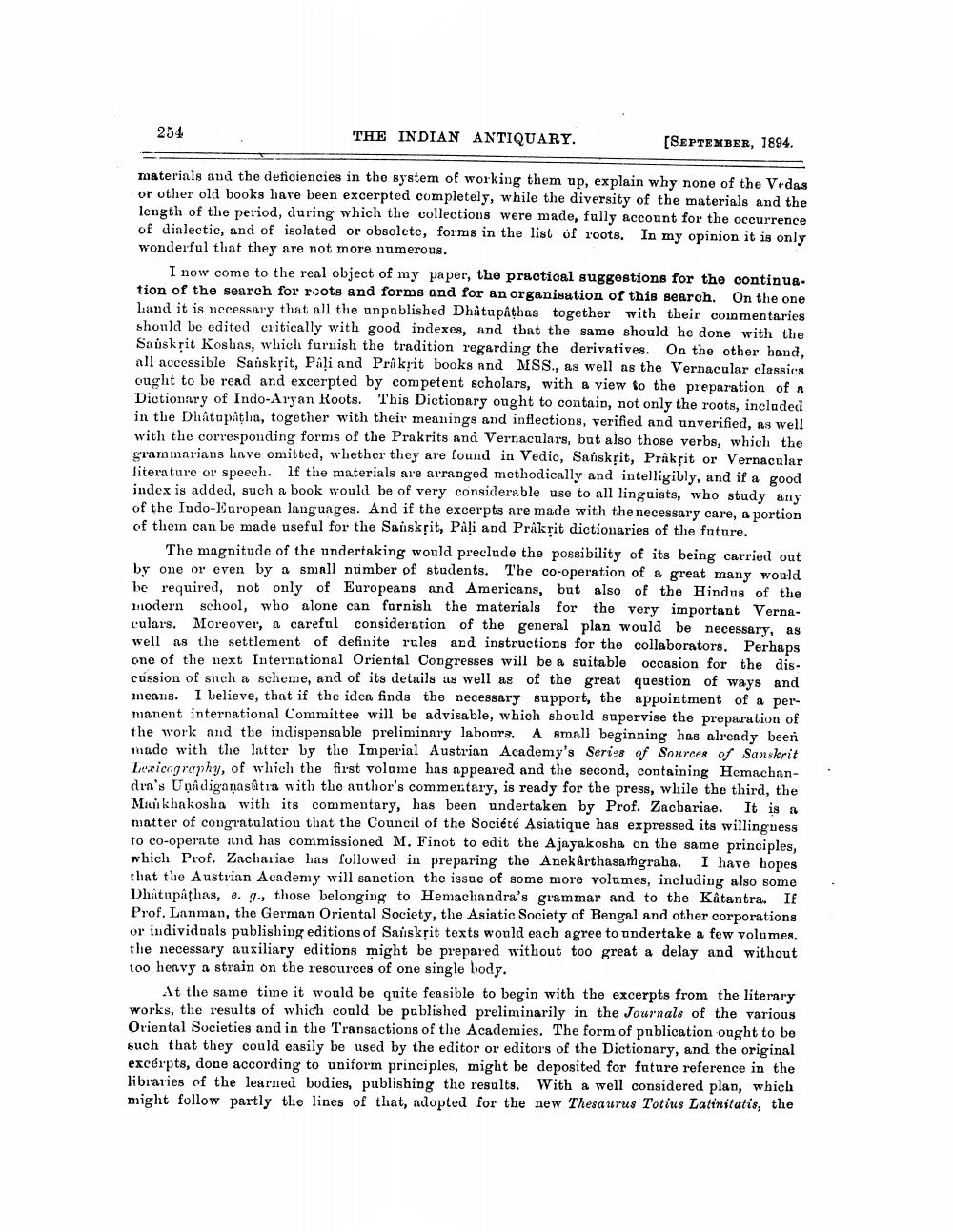________________
254
THE INDIAN ANTIQUARY.
[SEPTEMBER, 1894.
materials and the deficiencies in the system of working them up, explain why none of the Vedas or other old books have been excerpted completely, while the diversity of the materials and the length of the period, during which the collections were made, fully account for the occurrence of dialectic, and of isolated or obsolete, forms in the list of roots. In my opinion it is only wonderful that they are not more numerous.
I now come to the real object of my paper, the practical suggestions for the continua. tion of the search for roots and forms and for an organisation of this search. On the one land it is necessary that all the unpablished Dhatupatbas together with their coinmentaries should be edited critically with good indexes, and that the same should he done with the Sanskrit Koshas, which furnish the tradition regarding the derivatives. On the other hand, all accessible Sanskrit, Paļi and Prakrit books and MSS., as well as the Vernacular classics ought to be read and excerpted by competent scholars, with a view to the preparation of a Dictionary of Indo-Aryan Roots. This Dictionary ought to contain, not only the roots, included in the Dhatupathia, together with their meanings and inflections, verified and unverified, as well with the corresponding forms of the Prakrits and Vernaculars, but also those verbs, which the grammarians have omitted, whether they are found in Vedic, Sanskrit, Prâksit or Vernacular literature or speech. If the materials are arranged methodically and intelligibly, and if a good index is added, such a book would be of very considerable use to all linguists, who study any of the Indo-European langunges. And if the excerpts are made with the necessary care, a portion of them can be made useful for the Sanskrit, Påļi and Prakrit dictionaries of the future.
The magnitude of the undertaking would preclude the possibility of its being carried out by one or even by a small number of students. The co-operation of a great many would be required, not only of Europeans and Americans, but also of the Hindus of the modern school, who alone can furnish the materials for the very important Vernaculars. Moreover, a careful consideration of the general plan would be necessary, as well as the settlement of definite rules and instructions for the collaborators. Perhaps one of the next International Oriental Congresses will be a suitable occasion for the discussion of such a scheme, and of its details as well as of the great question of ways and means. I believe, that if the idea finds the necessary support, the appointment of a permanent international Committee will be advisable, which should supervise the preparation of the work and the indispensable preliminary labours. A small beginning has already been made with the latter by the Imperial Austrian Academy's Series of sources of Sanskrit Lexicography, of which the first volame has appeared and the second, containing Hemachandra's Uñadigaņasêtia with the author's commertary, is ready for the press, while the third, the Mankhakoshia with its commentary, has been undertaken by Prof. Zacbariae. It is a matter of congratulation that the Council of the Société Asiatique has expressed its willingness to co-operate and has commissioned M. Finot to edit the Ajayakosha on the same principles, which Prof. Zachariae has followed in preparing the Anekårthasamgraha. I have hopes that the Austrian Academy will sanction the issue of some more volumes, including also some Dhatupáthas, e. 9., those belonging to Hemachandra's grammar and to the Kåtantra. If Prof. Lanman, the German Oriental Society, the Asiatic Society of Bengal and other corporations or individuals publishing editions of Sanskrit texts would each agree to undertake a few volumes, the necessary auxiliary editions might be prepared without too great a delay and without too henvy a strain on the resources of one single body.
At the same time it would be quite feasible to begin with the excerpts from the literary works, the results of which could be published preliminarily in the Journals of the various Oriental Societies and in the Transactions of the Academies. The form of publication ought to be such that they could easily be used by the editor or editors of the Dictionary, and the original excerpts, done according to uniform principles, might be deposited for future reference in the libraries of the learned bodies, publishing the results. With a well considered plan, which might follow partly the lines of that, adopted for the new Thesaurus Totius Latinitatis, the




